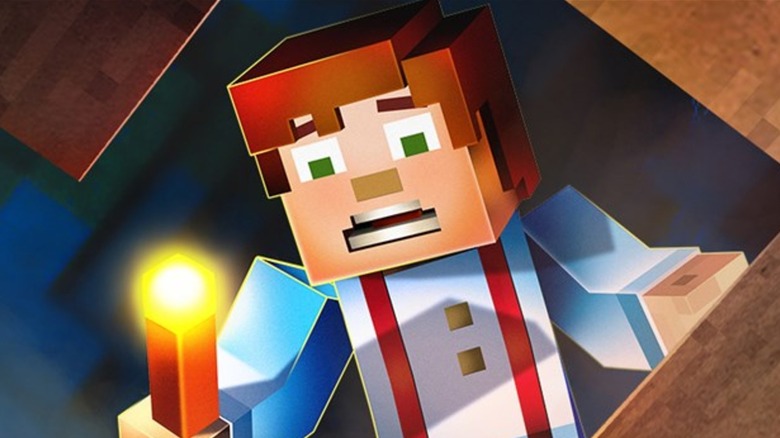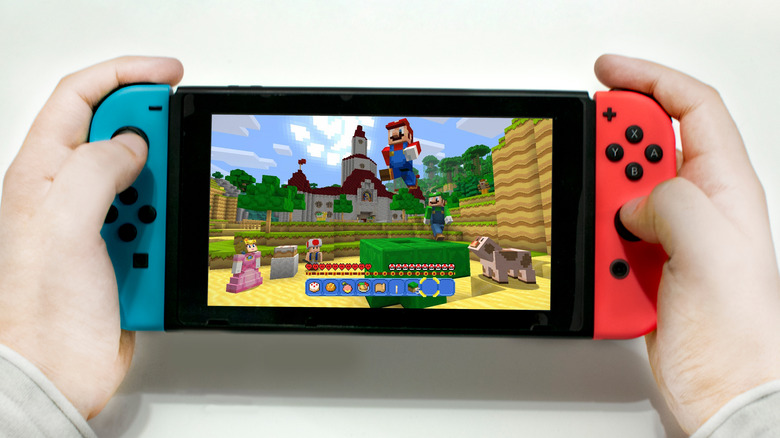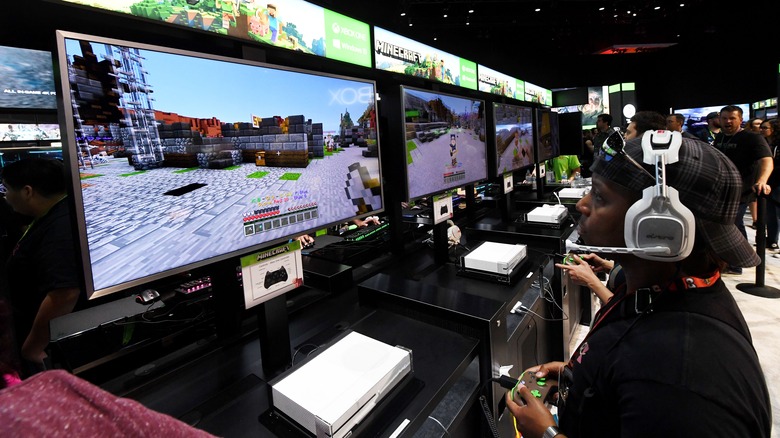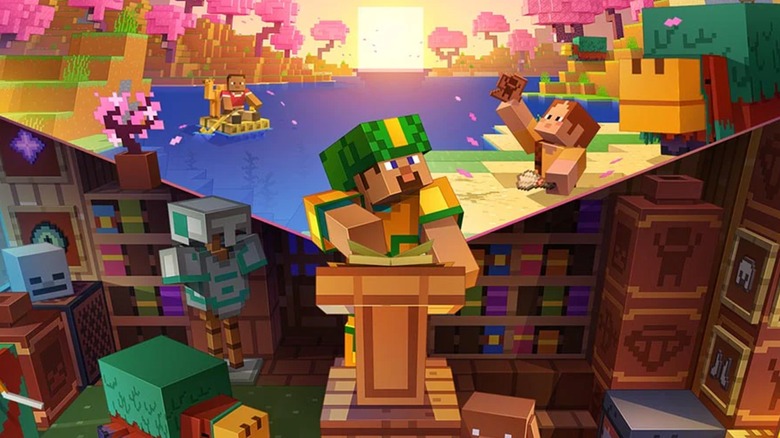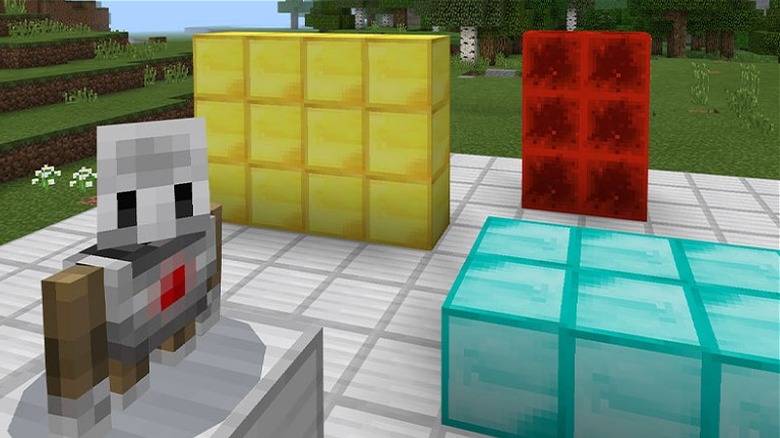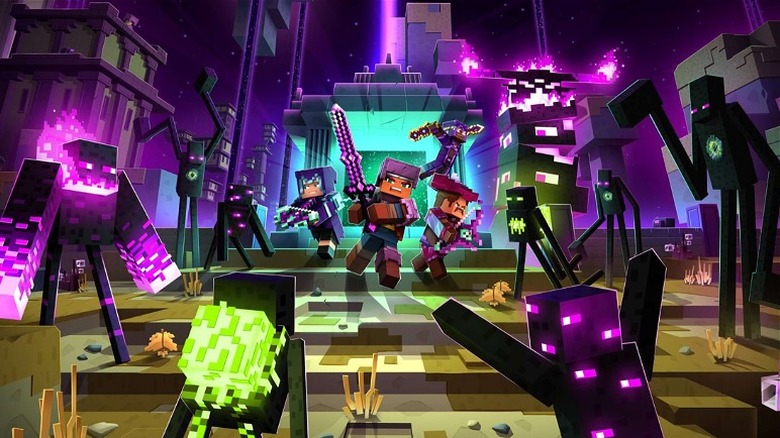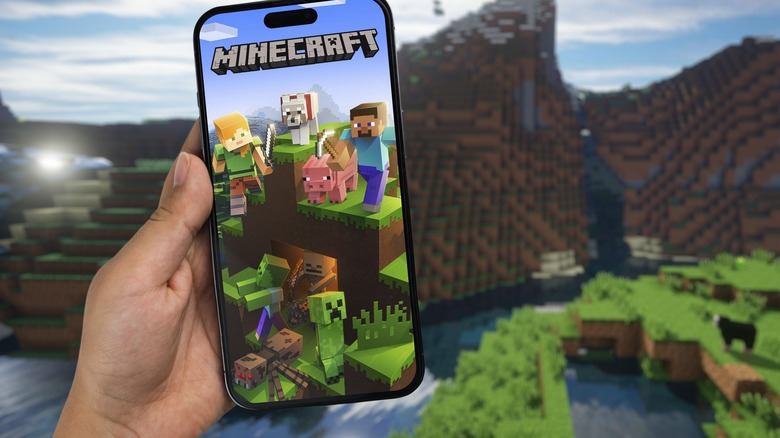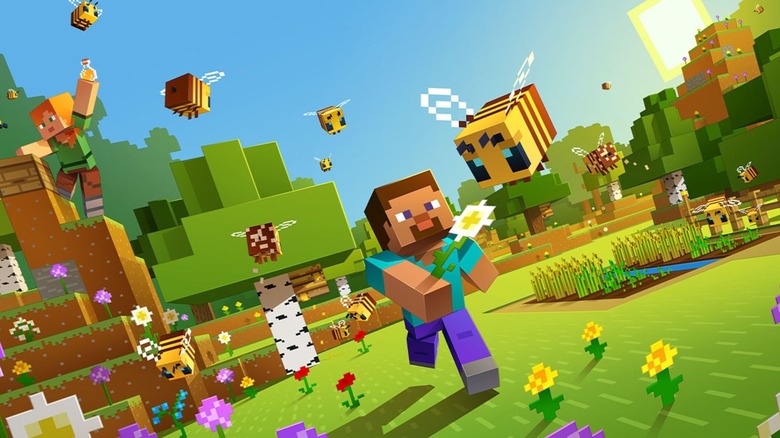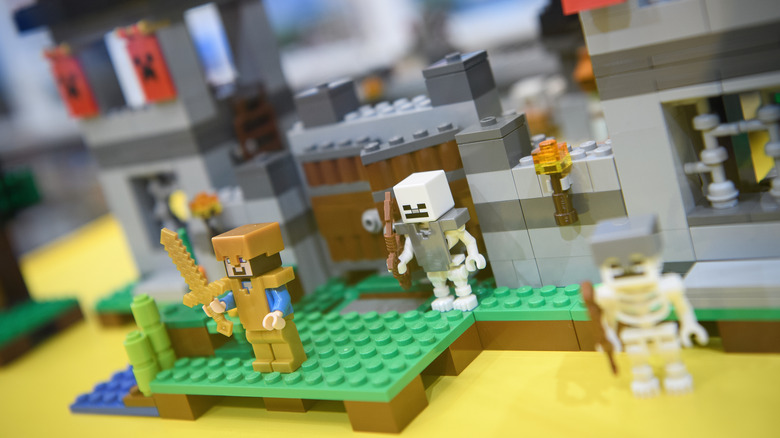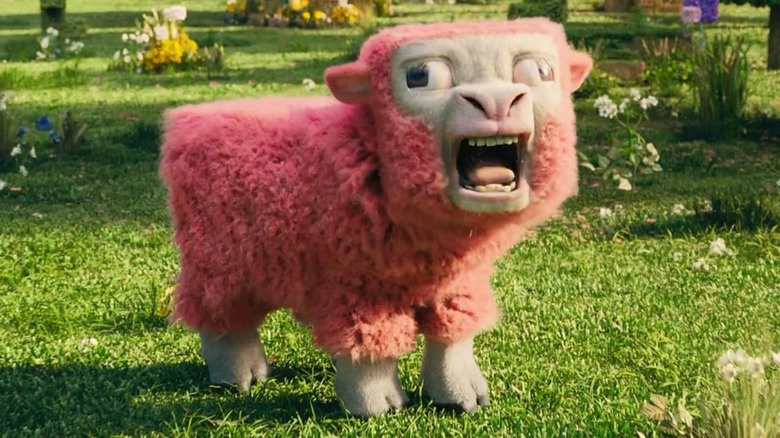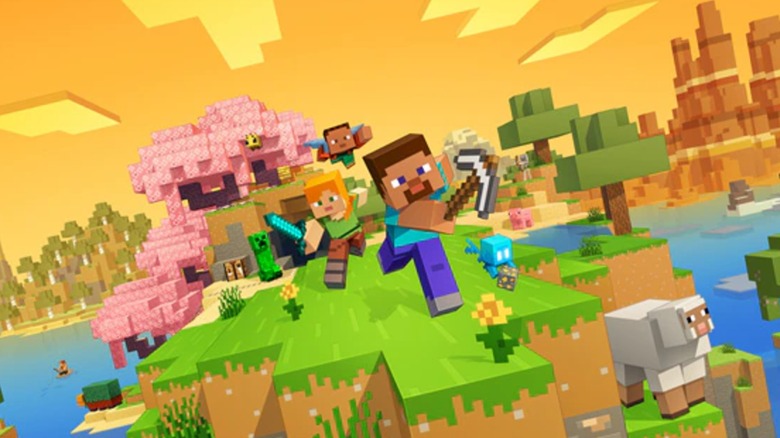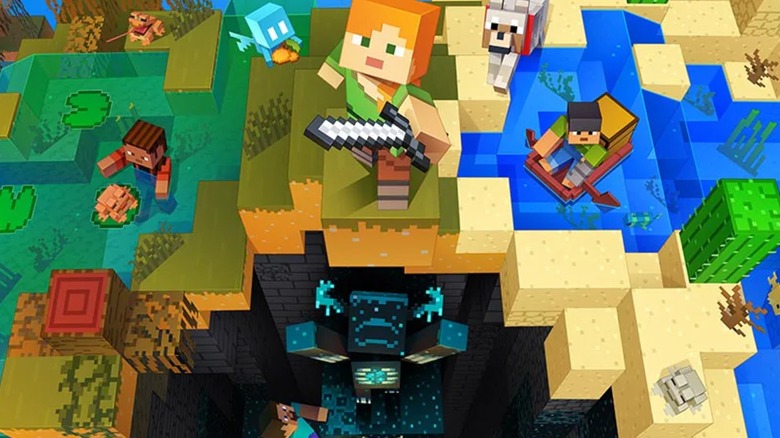Why Microsoft Won't Release Minecraft 2
"Minecraft" is an absolutely massive franchise. From its humble beginnings as a tiny indie game from a solo creator, "Minecraft" quickly rose to become a titan of the video game industry and beyond. With new updates coming around every corner, tons of spin-offs, a feature film adaptation, and other mass media endeavors being released to hungry fans, "Minecraft" is arguably bigger than it has ever been.
However, despite the success that "Minecraft" has seen across almost every platform, some fans still want to know if it will ever receive a sequel. There are a fair number of reasons why something like "Minecraft 2" isn't going to happen, even if it seems like it'd be a surefire hit. Here's why we don't think Microsoft will be releasing "Minecraft 2" anytime soon — as well as why it's probably for the best that it doesn't happen.
Minecraft is still expanding to new platforms
Unlike some other games, "Minecraft" is for everyone. Kids, parents, hardcore gamers, and casual fans all love it. That's one of the reasons why Microsoft was so interested in picking up the property. "For me, I look at it as a great game to add to our portfolio," Xbox boss Phil Spencer explained. "I love that male, female, young, and old — it's something that lives on so many different screens. I'd love to bring it to more screens out there."
So, how do you make sure that everyone who wants to play "Minecraft" actually can play "Minecraft?" You put the game on as many devices as possible. In 2014, shortly after Microsoft bought "Minecraft" and its parent company, Mojang, Microsoft brought the game to the Xbox One and PlayStation 4. The company followed that with a Vita edition and a mobile phone port. It didn't stop there, as "Minecraft" can be comfortably played on the Nintendo Switch, PlayStation 5, and Xbox Series X. Notice the trend? If it has a screen, Microsoft wants "Minecraft" to be there. After all, if the original game can still reach new players, Microsoft doesn't really need to worry about a sequel — and besides, if Mojang's developers are constantly porting "Minecraft" to new systems (and updating/optimizing said ports), they probably don't have much time to work on a brand new game.
The first game is still thriving
Here's what really makes "Minecraft" unique: It never really ends. No matter how much you love single-player adventures like "The Witcher 3," you'll eventually finish every quest. Playing the latest "Call of Duty" with friends is great, but someday those multiplayer servers are going to go down. Thanks to outside factors like player trades and unexpected injuries, annual sports titles like "Madden" are outdated almost as soon as they're released.
By contrast, "Minecraft" lasts forever. You'll never run out of seeds to explore or things to do. That's one reason why, more than ten years after "Minecraft" was first released to the public, millions and millions of people still enjoy it. Just look at the numbers. When Microsoft bought Mojang in 2014, the developer had sold about 54 million copies of "Minecraft." Since then, that sales figure has climbed to over 300 million copies sold, surpassing juggernauts like "GTA 5" and "Tetris" to become the best-selling video game of all time. As long as the original "Minecraft" is still chugging along (and bringing in the dough), there's no reason to release a follow-up. Not only would Microsoft be cannibalizing its own audience, but a new game takes time and money to make — and why bother, when everyone's still happy with the original?
Consistent updates make a sequel feel unnecessary
One of the reasons why players keep coming back to "Minecraft" is that Mojang and Microsoft are constantly adding new things to do. When "Minecraft" first launched, it was a relatively barebones affair. All it had was Survival Mode, in which players need to gather resources to build the tools and fortifications they need to outlast the game's various beasties. Before long, however, "Minecraft" creator Notch added an ultra-difficult Hardcore Mode, then followed that up with Creative Mode that lets players explore and build without worrying about potentially dying.
Those updates laid the foundation, and Minecraft's been a work-in-progress ever since, with Mojang regularly adding new mobs, biomes, and crafting materials to the mix. It's wild to compare how "Minecraft" looks nowadays to the way the game looked ten years ago; it's almost an entirely new game, in fact. Microsoft and Mojang don't seem to be planning on slowing down the updates any time soon, which isn't good news for a sequel. For one thing, making all of this new stuff takes time and resources. For another, all of these changes keep the existing "Minecraft" community busy and engaged. As we've seen, that kind of continued momentum renders a follow-up completely unnecessary. In fact, when the subject of a sequel comes up, it is often argued that pretty much anything that could be in a sequel would make just as much sense if it were put in a regular update. Save for a complete engine overhaul or graphical change (something that most fans would arguably be unhappy with), "Minecraft" is fine as it currently is.
There's nothing inherently broken that a "Minecraft" sequel could possibly fix, and for many video game fans, unnecessary sequels can be worse than no sequel at all. While innovative sequels can be great opportunities to push a franchise to the next level, a sequel that plays it safe and doesn't add anything new would be seen as an insult. On the other hand, some fans fear that a sequel that differentiates itself too much could lose what makes "Minecraft" so special. It's a lose-lose scenario.
Other applications for Minecraft
Now, just because a true sequel hasn't appeared doesn't mean that Microsoft hasn't released new "Minecraft" products. In 2016, the company launched "Minecraft: Education Edition, a special version of the game designed for use in schools. On the surface, "Minecraft: Education Edition" looks a lot like regular "Minecraft." It's got the same blocky graphics, the same user interface, and the same building tools that players have come to know and love. By using special in-game "lessons," however, "Minecraft: Education Edition" transforms the game into a virtual classroom. Want to learn how to code? "Minecraft" can teach you how. Interested in history? Use "Minecraft" to explore ancient China or the American Revolution. With "Minecraft: Education Edition," you can explore the world of "Romeo and Juliet," perform chemistry experiments, and compose music.
All that, and education is just one possible use for "Minecraft." There are many, many others. "Minecraft" is already used to develop artificial intelligence and as an architectural planning tool, and it's easy to imagine Microsoft commissioning other specialized versions of the game if demand warrants it. Those wouldn't be sequels, exactly, but they would be fresh takes on "Minecraft" all the same.
Microsoft can pursue more spinoff games
As previously mentioned, Microsoft is looking into other revenue streams and applications for "Minecraft," and one of those streams comes from spinoff titles and other types of games. For the company, it's not so much about the game itself as it is about the intellectual property. Microsoft is approaching "Minecraft" the same way Disney has used "Star Wars": licensing out the property for third-party development, and profiting off the title that way.
For instance, in late 2015 and early 2016, Mojang partnered with Telltale Games to release an eight-part, episodic series titled "Minecraft: Story Mode." The series was successful with critics and audiences alike, earning it a well-reviewed second season. These were followed by other spinoffs that pushed the franchise in new and exciting directions, including "Minecraft Dungeons" and "Minecraft Legends." Reception has varied for these, but they also neatly illustrate that Microsoft has many, many other ideas for "Minecraft" that go beyond the constraints of a traditional sequel.
Microsoft wants everyone to play together
The biggest obstacle that a potential "Minecraft" sequel faces isn't competition from other games, however. It's that Microsoft risks splitting its audience with a sequel. That makes "Minecraft 2" a hard sell, especially given that Microsoft is dedicated to bringing "Minecraft" fans closer, not splitting them apart.
"I think what we've learned through Xbox Live is something that we can help in unifying a little bit of what happens with 'Minecraft' today," Microsoft's Phil Spencer explained to IGN. "If I'm on PC, I get access to the mod servers; if I'm on console or the mobile editions, I don't. We're looking at how do we bring that whole system together a little more." Those aren't empty words, either. In 2017, Minecraft's Better Together Update introduced crossplay between PCs, mobile devices, and video game consoles, while the game's Bedrock Edition aimed to bring many disparate versions of "Minecraft" together in one unified platform. Since then, Microsoft has continued to do its best to unify the "Minecraft" community, and a sequel could undo all of that hard work.
Minecraft fans are reluctant to start over
"Minecraft," being a virtually endless sandbox game, is an ideal place for many players to relax and stretch their imaginations. There are so many different ways to play one of the most popular games of all time, from spending time fighting deadly mobs in a Survival world or flexing your architectural muscles in Creative Mode. It's easy to lose track of time "Minecraft," and many devoted players have spent hundreds of hours in their own custom worlds, carefully curating the environment to their whims. If "Minecraft 2" were to be released, fans fear they'd have to say goodbye to all their progress, or at least put it on the backburner.
This is an absolute dealbreaker for many hardcore "Minecraft" fans. Unless "Minecraft 2" includes an unprecedented amount of new content and quality-of-life updates (or it allowed players to seamlessly port their builds from one game to the next), it seems like a fair amount of "Minecraft" players would be hesitant to try and recreate hundreds of hours of progress. Other fans are worried about the effect a sequel might have on the modding community. As one fan on Reddit pointed out, "the mod makers would [have] to completely relearn everything from scratch."
Minecraft is already expanding elsewhere
Outside of spinoffs like "Minecraft: Story Mode" and "Minecraft Dungeons," the game has also spread into other forms of media and collectibles. This includes collaborations with LEGO, which is a no-brainer of a crossover. Since the first Micro World set dropped in 2013, the collaboration has yielded dozens of buildable sets, capturing the fun of in-game crafting in the real world. These sets let players build things from caves and the Nether, to axolotl-shaped houses and giant pigs.
"Minecraft" has also explored the realm of fiction, with multiple graphic novels and books being released to fill in the franchise's lore. Celebrated authors including Max Brooks ("World War Z") and Delilah S. Dawsom ("Servants of the Storm") have brought their talents to the franchise, fleshing it out in exciting new ways. Most of these novels explore the concept of various characters surviving in the "Minecraft" world, turning the survival game into a wider fantasy universe bursting with robust mythology. As of June 2023, over 5 million copies of the "Minecraft Official Novels" series have been sold, showing that the game has the potential to enchant under almost any circumstance. Although the prospect of "Minecraft 2" is interesting, seeing the unique mediums that "Minecraft" can explore — like novels, toys, and LEGOs — is arguably better for the series in the long run.
A Minecraft Movie is a reminder of the original game's continued popularity
While "Minecraft" has been successful in non-gaming endeavors, the franchise is undertaking an even larger challenge in the form of a live-action feature film, titled "A Minecraft Movie." The film follows four misfits who are transported into the world of "Minecraft." Here, they will meet Steve (the original "Minecraft" protagonist), and go on a magical quest to find their way home. The movie's first few teasers have received mixed reactions from fans, largely due to the strange animation style used for the "Minecraft" elements, as well as some of the offbeat humor. However, many fans found the second trailer to be much stronger.
In fact, the main knock against this trailer is that fans are concerned the movie won't live up to the source material! It remains to be seen how the final product will fare, but these trailers definitely capture the sense of wonder in "Minecraft," showing off many of the aspects of "Minecraft" that players fell in love with. Between the references to the game's soundtrack, appearances from iconic enemy mobs, and nearly 20 million YouTube views for the trailer in the first month, "A Minecraft Movie" is already a grand showcase of how attached players still are to the OG game. How could a sequel compete?
Minecraft's original creator is no longer involved
Well before it became the titan of the gaming industry that it is today, "Minecraft" started as a relatively simple indie game. So simple, in fact, that it was initially created by one person, Markus "Notch" Persson. Notch, as most fans refer to him, both developed and cultivated the early years of game before selling the IP to Microsoft in 2014. Although "Minecraft" has evolved greatly since then, Notch was the person who built the core of the game as fans know it. However, after selling the property, Notch stepped away from further development. Notch told the Wall Street Journal, "I don't want to be a symbol, responsible for something huge that I don't understand, that I don't want to work on."
However, despite Notch's disinterest and lack of involvement in the intervening years, some fans still believe that a "Minecraft" sequel would be a misguided effort without Notch leading the way. Plus, with Notch falling into various controversies — including coming under fire for various political and racially-charged comments — it seems fairly unlikely that Notch would be asked to join the production team for "Minecraft 2."
Minecraft's creator already ruled out a sequel idea
Strangely enough, although Notch is no longer officially affiliated with "Minecraft," the original creator released a post on X that sparked the interest of fans. In this post, Notch claimed that he had been toying with building out an idea that could be considered a spiritual successor to "Minecraft." Although this game wouldn't be an official sequel, Notch stated, "I basically announced 'Minecraft 2.'" Of course, this drove many fans wild with ideas, with most of the community spreading the news of "Minecraft 2" around every corner of the internet.
However, all hope for "Minecraft 2" vanished almost as quickly as it appeared. Notch later admitted later that, despite overwhelming fan support, he wasn't particularly interested in making any kind of "Minecraft 2." Instead, he announced plans to work on a roguelite game called "Levers and Chests." When even the creator of "Minecraft" changes their mind about making "Minecraft 2," it's hard to imagine anyone else doing it anytime soon.

